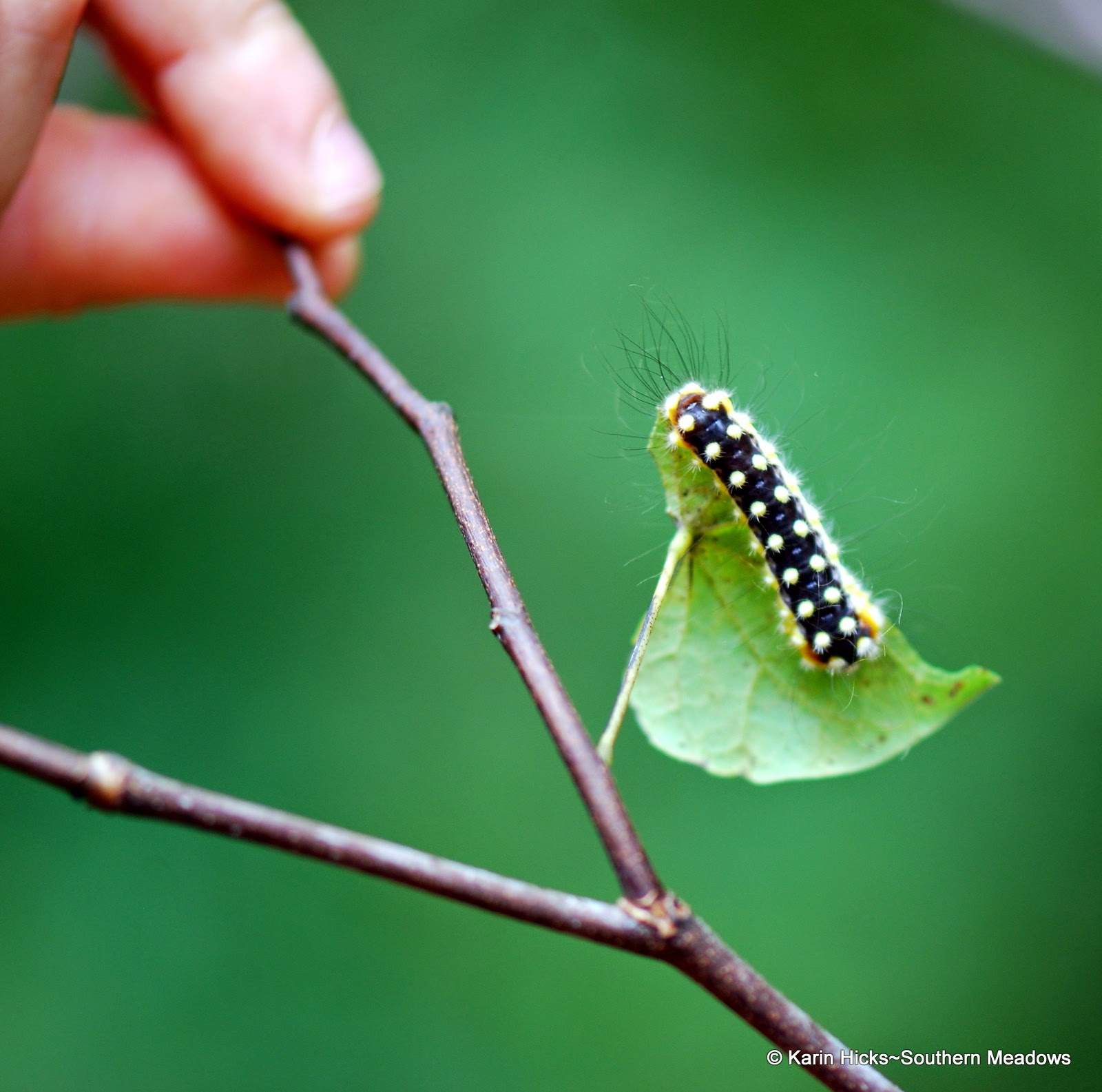Finding Caterpillars of the Moth Variety
I am often asked to talk on butterfly gardening because people love having them flutter around their garden. Moths often take a back seat to butterflies since most of them fly at night and lets be honest they have a reputation as being a pest. This is unfortunate because they produce some of the most spectacular caterpillars and they are an important factor in a diverse garden habitat not only as pollinators but also as a food source.
The cooler, autumn temperatures mean that we are spending significantly more time in the garden and it is an excellent time to go exploring. In the past two weeks our boys have found several extraordinary species of moths in their larval stage.
We identified this one as the white flannel moth caterpillar (Norape ovina). It probably doesn't feel much like flannel and we're not about to touch it since it is a stinging caterpillar. It would be quite painful if you brushed against those clumps of short hairs covering its side and back and long hairs extruding from its body.
A surprising find was this hornworm caterpillar on the holly 'Winter Gold'. I believe this to be the Pawpaw sphinx (Dolba hyloeus). It will host on blueberries, hollies, pawpaw, inkberry and sweetfern. As you can see this caterpillar is covered with cocoons of pupating braconid wasp so it won't be alive for long. It is our garden habitat at work.
Based on posts on Facebook and talking to fellow Master Gardeners the saddleback caterpillars (Acharia stimulea) are having a boom year. We found several on our coral honeysuckle plant. They are generalist so they feed on a variety of garden plants including aster, blueberry, buttonbush, maple, oak apple, cabbage and citrus.
There is no denying this alien looking caterpillar is a cool find but it is most often associated with its effect on humans if we rub up against one. It will cause painfully stinging and a rash. What I find so fascinating is how such colorful caterpillars turn into such plain looking moths.
I often wonder when we find new species of insects in our garden if they were always there but our eyes hadn't been trained to find them yet or if they found our garden due to our habitat restoration efforts. Either way, they are a reassuring sign. I encourage everyone to get out in your garden or local park and check the underside of leaves and see what you find. Happy exploring!
The cooler, autumn temperatures mean that we are spending significantly more time in the garden and it is an excellent time to go exploring. In the past two weeks our boys have found several extraordinary species of moths in their larval stage.
 |
| white flannel moth caterpillar on redbud tree |
We identified this one as the white flannel moth caterpillar (Norape ovina). It probably doesn't feel much like flannel and we're not about to touch it since it is a stinging caterpillar. It would be quite painful if you brushed against those clumps of short hairs covering its side and back and long hairs extruding from its body.
My son found one caterpillar munching away at the edge of a redbud leaf. Of course we spent several minutes looking for more and found at least seven on the underside of the leaves. These distinctively patterened black, yellow and orange caterpillars are pretty easy to spot once you start looking. Interestingly this colorful caterpillar will become a very ordinary white moth. According to my go to caterpillar book "Caterpillars of Eastern North America" by David L. Wagner, these caterpillars are found on black locust, elm, hackberry, redbud, greenbriar and other woody plants.
While we were inspecting the redbud we found another fuzzy caterpillar, the American dagger moth (Acronicta americana). This is another one you don't want to touch since it can cause an irritation on your skin. We've found these in our garden before but never on the redbud tree.
 | |
| American Dagger Moth on Redbud |
This is a fairly large sized caterpillar which is covered in fuzzy yellow or white hairs with distinctive black tufts. These caterpillars feed on a variety of host plants which include woodland trees: alders, maples, oaks, redbuds, poplar, elm, chestnut, birch, box elder, and willow. They are usually found on the underside of the leaves in the fall. They overwinter in their cocoons and emerge as brown moths the following summer. An important reason not to clean up all the leaf litter in your garden.!
 |
| Pawpaw Sphinx caterpillar on Holly 'Winter Gold' |
Based on posts on Facebook and talking to fellow Master Gardeners the saddleback caterpillars (Acharia stimulea) are having a boom year. We found several on our coral honeysuckle plant. They are generalist so they feed on a variety of garden plants including aster, blueberry, buttonbush, maple, oak apple, cabbage and citrus.
 |
| Saddleback caterpillar on coral honeysuckle |
I often wonder when we find new species of insects in our garden if they were always there but our eyes hadn't been trained to find them yet or if they found our garden due to our habitat restoration efforts. Either way, they are a reassuring sign. I encourage everyone to get out in your garden or local park and check the underside of leaves and see what you find. Happy exploring!


.png)
